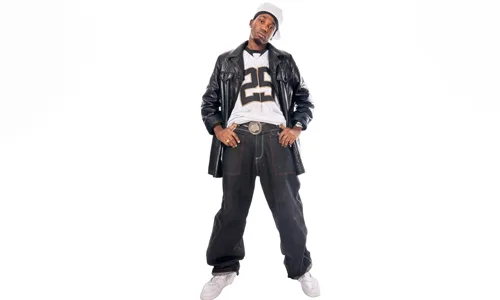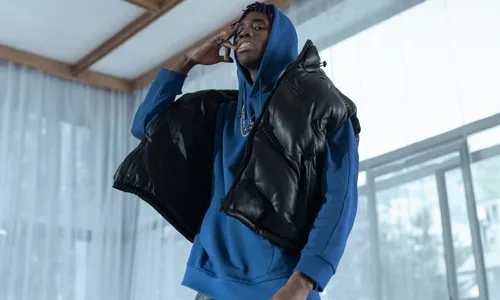
From Bronx Streets to High Fashion: The Enduring Influence of Hip-Hop Style
- May 3, 2025
- 5 months ago
- 151 Views
Hip-hop isn't just a genre of music; it's a cultural movement that's had a profound impact on everything from language to social justice. But its influence extends far beyond lyrics and beats – it's revolutionized the way we dress.Hip-hop's impact on fashion is undeniable.
Born in the streets of the Bronx in the 1970s, hip-hop fashion reflected the ingenuity and resourcefulness of its creators. Breakdancers rocked baggy clothes for ease of movement, DJs sported tracksuits for comfort, and rappers adopted whatever was readily available, often turning thrift store finds into iconic looks. These early fashion choices weren't just about practicality; they were a statement of identity and belonging.
From Streetwear Staples to Cultural Icons
Early hip-hop fashion was all about self-expression and individuality. Artists like Run-D.M.C. championed Adidas sneakers and tracksuits, elevating them from sportswear to cultural statements. Their song "My Adidas" became an anthem, solidifying the brand's association with hip-hop culture. LL Cool J's Kangol hat became a symbol of effortless cool, and gold chains, once associated with wealth, became a badge of identity and community.
The 1980s saw the rise of gangsta rap, and its fashion took a sharper turn.
N.W.A. popularized baggy Dickies pants, white tees, and Raiders caps, reflecting the realities of their Los Angeles environment. This raw aesthetic resonated with a generation, blurring the lines between street style and high fashion. It wasn't just about the clothes; it was about a visual representation of their struggles and experiences.
Beyond the Coasts: Regional Influences on Hip-Hop Style
Hip-hop fashion wasn't monolithic. Different regions developed their own unique styles. In the South, Miami bass music influenced a flashier aesthetic with brightly colored clothing, bucket hats, and gold jewelry. On the West Coast, the rise of gang culture saw the adoption of bandanas, baggy jeans, and graphic tees.
These regional variations showcased the diversity within hip-hop culture and how fashion served as a way for different communities to express themselves.

Crossover Appeal: Hip-Hop Hits the Mainstream
By the 1990s, hip-hop was a global phenomenon. Artists like Tupac and Biggie Smalls became style icons, influencing not just clothing choices but also hairstyles and accessories. Brands like Fubu and Tommy Hilfiger embraced the oversized silhouettes and bold logos favored by rappers. This mainstream acceptance wasn't without controversy, with some critics accusing brands of cultural appropriation.
However, it undeniably opened doors for wider representation and appreciation of hip-hop style.

The rise of MTV and music videos further solidified the link between hip-hop and fashion. Artists like Missy Elliott and Lauryn Hill challenged traditional notions of femininity, introducing athletic wear and baggy clothing into the mainstream. They proved that hip-hop fashion wasn't just for men, paving the way for a more inclusive and diverse fashion landscape.
Hip-Hop Goes High Fashion: A New Era of Collaboration
The early 2000s saw a fascinating shift. Luxury brands began collaborating with hip-hop artists, recognizing their immense cultural influence. Jay-Z's partnership with Reebok and Kanye West's foray into shoe design with Louis Vuitton blurred the lines between high fashion and streetwear. This move wasn't just about profit; it was about legitimizing a previously marginalized style.

Image Source; Getty Images
This new era of collaboration wasn't without its critics.
Some argued that it commercialized hip-hop and diluted its authenticity. However, it also opened doors for new design talents from within the hip-hop community and created a space for more diverse voices in the fashion world.
Beyond Clothes: The Impact of Hip-Hop Footwear

It's impossible to talk about hip-hop fashion without mentioning footwear. Sneakers have always held a special place in hip-hop culture. From Run-D.M.C. 's fight for the right to wear Adidas superstars without laces to Kanye West's Yeezys becoming a billion-dollar brand, sneakers have transcended their practical purpose to become coveted cultural artifacts. Collaborations between rappers and sneaker brands like Nike's Air Jordans or Adidas' Yeezys fueled a sneaker collecting culture and cemented their place as a key element of hip-hop style.

Hip-Hop Goes Global: A Movement Without Borders
Hip-hop fashion's influence isn't limited to the United States. From Europe's grime scene to South Korea's K-Pop, hip-hop has inspired unique fashion expressions around the world. In Japan, streetwear heavily influenced by American hip-hop has evolved into a distinct style with a focus on bold graphics, layering, and technical innovation. In Europe, the rise of grime music in the UK saw the adoption of tracksuits, bucket hats, and a more utilitarian aesthetic.
These global variations showcase the adaptability of hip-hop fashion and its ability to resonate with different cultures and social contexts.
More Than Just Clothes: Hip-Hop Fashion's Legacy
Hip-hop fashion is more than just trendy clothes and expensive sneakers. It's a reflection of a culture rich in storytelling, self-expression, and a constant push for boundaries. It's about celebrating individuality, community, and the power of self-invention. Early hip-hop artists used fashion to challenge societal norms and redefine what it meant to be stylish.
They weren't afraid to break the rules and wear what they wanted, on their own terms. This rebellious spirit continues to influence fashion today, encouraging people to embrace their own unique style.
The Future of Hip-Hop Fashion: Innovation and Evolution

Looking ahead, hip-hop fashion shows no signs of slowing down. New generations of artists are pushing the boundaries, incorporating elements of athleisure, vintage finds, and high-end collaborations. Sustainability and ethical production are becoming increasingly important aspects of the hip-hop fashion conversation. Designers like Virgil Abloh (Off-White) and Kerby Jean-Raymond (Pyer Moss) are using their platforms to address social issues and challenge the status quo within the fashion industry.
One thing's for sure: hip-hop fashion will continue to evolve, reflecting the ever-changing cultural landscape it was born from.
It's a testament to the enduring power of self-expression and the ability of style to tell a story. From the streets of the Bronx to the runways of Paris, hip-hop fashion has left an undeniable mark on the world, proving that style can be more than just what you wear – it can be a powerful form of self-expression and cultural commentary.







